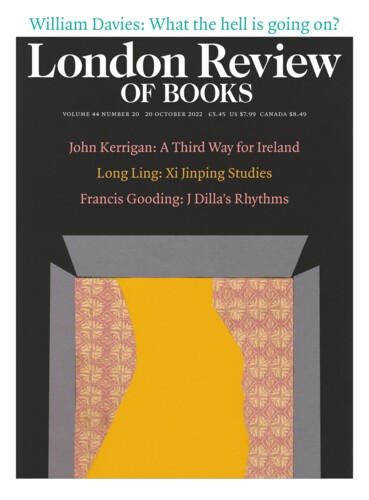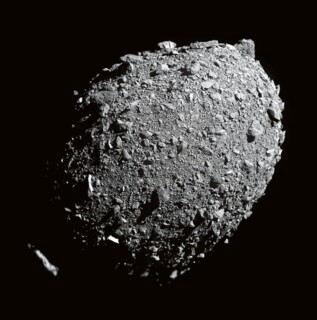Where the Earth and the other rocky planets of the solar system orbit today, there were once, five billion years ago, more than twenty worlds larger than the Moon, several perhaps as large as Mars. Collisions were common. Rocks brought back from the Moon by the Apollo astronauts tell us that one of these worlds, often known as Theia, hit the still-forming Earth, destroying itself and forming the Moon from the debris produced by the impact. Collisions between large bodies may also be responsible for altering the rotation of Venus, which takes longer to spin on its axis than it does to orbit the Sun and hence has a day longer than its year; for the surprising density of Mercury, which may once have been larger, but had its outer layers knocked off; and for the differences between the rugged southern and smooth northern hemispheres of Mars.
Further out, beyond Mars, Jupiter’s gravity prevented large bodies from forming. This region today is host to the asteroid belt. The biggest thing in it is Ceres, nearly six hundred miles across and, like Pluto, now known as a dwarf planet. When it was spotted by Giuseppe Piazzi in 1801, Ceres was regarded as a new planet, the solar system’s eighth, but as discoveries of asteroids mounted they became regarded by astronomers as not much more than an inconvenience. Walter Baade called them the ‘vermin of the skies’.
The vast majority of the 616,690 asteroids with orbits well-determined enough to be given a catalogue number are in the asteroid belt, but even in these relatively crowded conditions, collisions are now rare. Space is emptier than you might think. I was raised on science fiction that was forever allowing starships to dodge through and hide behind asteroids, but even in the main belt there is often a million miles between neighbouring bodies. Collisions are unlikely anywhere in today’s stable solar system, and humanity has been happy, for most of its existence, to ignore the possibility of a threat from the skies.
In the bottom of an out-of-the-way display case at Oxford’s Natural History Museum – set apart from the impressive casts of dinosaur skeletons, the newly installed carapace of a giant spider crab and the remnants of Lewis Carroll’s dodo – is a lump of grey rock, a little bigger than a house brick. I often go to look at this nondescript piece of 66-million-year-old sediment, straining to see the thin, pale stripe that runs through its middle, a record of the impact that caused the extinction of the dinosaurs. The line marks the boundary between the Cretaceous and Palaeogene periods, a layer of debris found in deposits not only near the site of the impact at Chicxulub, beneath Mexico’s Yucatán peninsular, but as far as away as China. It’s rich in iridium, an element overabundant in meteorites, and the assumption is that debris flung up from the asteroid impact gradually drifted down across the globe.
Iridium was found in this boundary layer in 1980, at a time when about fifty asteroids were known to be on orbits that crossed the Earth’s. In the forty years since, the catalogue of Near Earth Objects, or NEOs, has grown rapidly. The thirty-thousandth entry will be added sometime in the next twelve months. Most of the catalogued objects are at least tens of metres across, big enough to hurt if they hit an unwary planet. None seems overly threatening, though there has been the odd false alarm: 2007 VN84, an incoming object that seemed likely to miss us by only a few thousand miles, turned out to be the European Space Agency’s Rosetta spacecraft swinging by on the way to a comet.
Impacts do happen. In 2013, a meteoroid perhaps twenty metres across exploded thirty kilometres above the Russian city of Chelyabinsk, producing a shock wave that broke windows, set off car alarms and injured more than a thousand people. Last month, a smaller rock blazed across the skies of Scotland and Northern Ireland, producing a brilliant blue bolide that easily outshone the background stars before ditching in the Atlantic Ocean somewhere to the north of Derry. Such events cause surprisingly little damage. There is no reliable record of anyone being killed by a meteorite strike, and they may even bring benefits. In 1992, 17-year-old Michelle Knapp of Peekskill, New York, had recently bought a Chevrolet Malibu for $300. After the car was smashed beyond repair by the impact of a large meteorite, she sold it to a collector for $25,000.
Meteoric rain falls on us constantly. In 1872, just before Christmas, the crew of HMS Challenger set off from Portsmouth to investigate the deep ocean. Among their discoveries over the next three and a half years was the deepest point on the sea bed, at the southern end of the Mariana Trench, a spot now known as Challenger Deep. By modern standards their methods were crude – they determined their position by looking at the stars, and sounded the ocean depths by dropping rope – but the voyage laid the foundations of oceanography as a science. Dragging a magnet through samples dredged from the seafloor in the middle of the ocean, far from land, produced a haul of small particles that were clearly micrometeorites, space dust that had fallen over the centuries. Modern estimates, using methodology not so far removed from the Challenger’s dredge-and-see routine, suggest a flux of ten particles per square metre per year, which adds up to thousands of tonnes annually over the planet’s surface, and ensures that, unless you have cleaned your gutters recently, they probably harbour a few motes of extraterrestrial dust.
Somewhere out there, moving steadily on its orbit, is the next large impactor that will hit the Earth, and a lot depends on its size. An asteroid a hundred metres across landing in the wrong place would destroy a city; one a kilometre in diameter would be big enough to have an effect on the global climate similar to a nuclear strike, plunging the world into long-lasting winter. If something the size of the Chicxulub impactor, perhaps 15 km across, were to arrive, we probably wouldn’t fare any better than our reptilian predecessors.
The Vera Rubin Observatory, which is assembling the world’s largest survey telescope on a remote mountaintop in the Chilean Atacama, will over the next decade find more than five million new asteroids (as long as the large numbers of satellites being launched by companies such as Elon Musk’s SpaceX don’t get in the way; they are especially prominent just after sunset and just before sunrise, prime viewing periods for near-Earth asteroids). The most worrying of the asteroids currently being tracked is 101955 Bennu, 250 metres across, which has a 0.057 per cent chance of hitting the Earth between the years 2178 and 2290. The Osiris-Rex spacecraft recently paid a visit (it stands for ‘Origins, Spectral Interpretation, Resource Identification, Security-Regolith Explorer’). Bennu turns out to be not a nice solid rock but a celestial rubble pile, making sampling harder, But Osiris-Rex is bringing about sixty grams of asteroid back to Earth for further analysis, in the hope that a better understanding of its composition might allow us to take appropriate action should the gravitational tides washing the solar system shift Bennu’s orbit just enough to cause trouble.
In the event of an incoming asteroid, Hollywood has a few ideas. Last year’s Don’t Look Up showed the world ignoring warnings from Leonardo DiCaprio and Jennifer Lawrence, but 1998 was the high-water mark for asteroid anxiety, giving us both Deep Impact (Robert Duvall and a team of astronauts blow up the asteroid with nuclear weapons; it mostly works) and Armageddon (Bruce Willis and a ragtag band of oilmen blow up the asteroid with nuclear weapons; it works). In real life, even assuming it were possible to fire a missile at a small, moving target a few million miles away, the most likely effect of nuking an incoming asteroid would be to produce a set of radioactive asteroid fragments, all still heading towards Earth.
Other interventions have been mooted. One of the more appealing notions was to paint the incoming asteroid a different colour, changing the effect on it of solar radiation and so nudging it aside, but recent work suggests that a million years or more would be needed for that to make a difference. A ‘gravity tractor’ would involve a massive object being placed in orbit around the offending asteroid to drag it off course, but launching something big enough and getting it rapidly into orbit around the asteroid is beyond our abilities. Rosetta’s trip to Comet Churyumov-Gerasimenko followed a convoluted path dictated by celestial mechanics, including fly-bys of Mars and Earth, taking ten years to match its orbit to that of its target – time we are unlikely to have when facing a possible impactor.
Instead, we turn to a ‘kinetic impact’, or hitting an approaching asteroid head on. Even a small push, delivered far enough before impact, should make a big difference, and space agencies around the world have spent a lot of time contemplating their shots in a game of interplanetary snooker. While snooker, played with solid balls that bounce off each other in a fair approximation of what physicists call elastic collisions, may (at least in theory) be a simple game, the effects of slamming a spacecraft into a target like Bennu, perhaps no more solid than a sand dune, are distinctly more difficult to model and predict.
Nasa’s Double Asteroid Redirection Test (Dart) was a mission carried out by a spacecraft the size of a golf cart, which hit the asteroid Dimorphos on Monday, 26 September. Dimorphos, about the size of a cricket field, is in orbit around Didymos, a larger asteroid four hundred metres across, making the effect of Dart’s impact easily detectable in a change to the system’s orbital period.
During the final stages of its approach, Dart was too far from Earth for its creators to control it directly, so the on-board navigation system had to locate, lock onto and hit the right asteroid. The team in mission control at the Applied Physics Laboratory in Maryland handed over control to Dart’s computer with about a minute to go, and everything worked perfectly. Dart scored a bullseye, hitting the target within 17 metres of the intended spot after a flight of 11 million kilometres. The final image it sent back, showing the asteroid’s rock-strewn surface, faded to red as its signal was cut off.
The data received in the minutes before impact showed a world of dust and rock held loosely together by the asteroid’s weak gravity field and ripe for disruption. Dart’s direct hit was visible from Earth, with even back-garden telescopes showing a considerable brightening of the Didymos/ Dimorphos system as ejecta from the impact sprayed up into sunlight. Larger, robotic instruments in South Africa and Chile showed the cloud of debris expanding out into space. Four days later, the dust was still there, forming a tail ten thousand kilometres long that now accompanies the twin asteroids in their orbit around the Sun. It’s possible that such effects may have cushioned the impact, preventing any significant change in Dimorphos’s orbit, though we will have to wait for new measurements over the coming weeks and months. For now, we know that we can successfully strike an incoming asteroid. Real progress, and certainly well ahead of anything the dinosaurs achieved, even if we have yet to show we can save ourselves from their fate.
Listen to Chris Lintott discuss asteroids with Thomas Jones on the LRB Podcast.
Send Letters To:
The Editor
London Review of Books,
28 Little Russell Street
London, WC1A 2HN
letters@lrb.co.uk
Please include name, address, and a telephone number.


